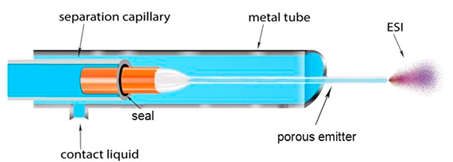Porous Emitter CE-MS Interface
Recently, Dick Smith and co-workers reported an approach which may be regarded as propagation of his original work to a CE-MS interface [1]. In the final implementation, they describe a fused-silica emitter with a porous tip (90 µm o.d.) which is shoven into the separation capillary (365x100 µm i.d.) and glued to fix its position [2].

CE-MS Interface according to R.D. Smith et al.
The assembly is contained in a T-piece where the assembly of separation and emitter capillaries is shifted through a steel tube (1.0 mm i.d.). The third leg of the T-piece is connected to a contact liquid (2% acetic acid), which is delivered by a syringe. Prior to each run, the contact liquid is refreshed. The ESI voltage is applied to the steel tube (figure 6). Essential in this work though is the combination of the narrow i.d. emitter with standard CE separation capillary. In this way, the interface eliminates the necessity of working with very narrow i.d. separation capillary as in the approaches by Moini and Dovichi. The EOF in the separation capillary is suppressed by coating the inner surface with hydroxyl propyl cellulose. The CE separation used is a capillary isotachophoresis (CITP) method allowing sample injection up to 2.5 µL or 33% of the volume of the separation capillary. CITP provides analyte focusing, and peptide concentrations down to sub nM could be measured.
[1] Smith R.D., Barinaga C.J., Udseth H.R. (1988) Anal Chem 60 1948-1952
[2] Wang C, Lee CS, Smith R.D., Tang K (2013) Anal Chem 85 7308-7315
